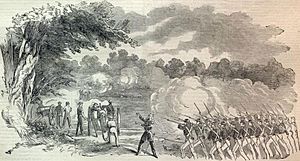Union Army of the West facts for kids
The Union Army of the West was a group of soldiers who fought for the Union during the American Civil War. They were active in the western part of the country, mainly in Missouri. This army was quite small, with only four main groups of soldiers called brigades. It was formed in May 1861 and stopped existing in August 1861. The Army of the West was led by Brigadier general Nathaniel Lyon until he was killed in the Battle of Wilson's Creek on August 10, 1861.
Why the Army Was Formed
Before the Civil War began, Missouri was already having problems. People who wanted slavery and people who didn't were fighting along the border with Kansas. Both sides attacked each other's areas. There was a lot of trouble and fear in the region.
When the Civil War started, Missouri had to decide if it would join the Confederacy (the Southern states that left the Union) or stay loyal to the Union. The governor of Missouri, Claiborne Fox Jackson, secretly planned for Missouri to join the Confederacy. He knew the most important place in the state was the federal (Union) arsenal in St. Louis, where weapons were stored. Only a small group of Union soldiers, led by Captain Lyon, guarded it. Governor Jackson called out his state's army, called the militia.
Meanwhile, the U.S. Secretary of War, Simon Cameron, sent a letter to Captain Lyon. The letter allowed Lyon to gather more Union soldiers. President Abraham Lincoln and Lieutenant general Winfield Scott approved this.
On May 10, 1861, Lyon surrounded the camp of the Missouri Militia. He took all their members prisoner. He marched them through the streets of St. Louis to the arsenal. When people in St. Louis who supported the South started a violent protest, Lyon quickly stopped it. Many of the rioters were killed.
Later, Brigadier general William S. Harney returned to St. Louis. He brought more Union soldiers and cannons. He told the people of St. Louis that the Union army would protect them. He also said that the governor and state lawmakers were wrong for trying to join the South. On May 17, 1861, Lyon was promoted to brigadier general. He was now in charge of the Union forces in Missouri.
How the Army Fought
The Union Army of the West was formed when Nathaniel Lyon became a brigadier general and took overall command. His forces were a mix of regular U.S. Army soldiers and volunteers from Missouri, Iowa, and Kansas. The Army of the West had these main groups:
- 1st Brigade: Led by Major Samuel D. Sturgis. This group had 184 men, including infantry (foot soldiers), dragoons (soldiers who rode horses but fought on foot), and artillery (cannons).
- 2nd Brigade: Led by Colonel Franz Sigel. This group had 1,200 men, including infantry, cavalry (soldiers on horseback), dragoons, and artillery.
- 3rd Brigade: Led by Lieutenant colonel George L. Andrews. This group had 1,116 men, including infantry and artillery.
- 4th Brigade: Led by Colonel George W. Deitzler. This group had 2,400 infantry soldiers.
On June 13, 1861, talks with Governor Jackson failed. Lyon quickly moved his army to attack the pro-Confederate forces in Jefferson City, Missouri, the state capital. He moved so fast that he caught them by surprise. On June 15, the Army of the West took control of Jefferson City.
Two days later, on June 17, both sides fought the Battle of Boonville. This battle lasted only about 30 minutes. The Union forces completely defeated the pro-Confederate soldiers. Governor Jackson and most of his militia moved back to the southwest corner of Missouri. They were hoping for help from Confederate soldiers in Arkansas.
By early July 1861, the Army of the West was camped in Springfield, Missouri. Lyon had about 5,400 soldiers in total. About 75 miles southwest of Springfield, the pro-Southern militia was camped. They were led by Major general Sterling Price. Price was joined by Confederate generals Benjamin McCulloch and Nicholas Bartlett Pearce. Together, their forces had about 12,000 soldiers. In late July, both armies started moving closer to each other.
On August 9, 1861, Lyon marched his troops from Springfield to where the Confederates were camped at Wilson Creek. His plan was for Colonel Sigel to attack the Confederates from their side or back. The rest of Lyon's forces would attack from the front.
On August 10, the Battle of Wilson's Creek began. Sigel's surprise attack gave the Union army an early advantage. The two armies fought very hard in the fields and hills around Wilson's Creek. After six hours of fighting, many soldiers on both sides were killed or hurt. The Union forces then pulled back. During the battle, General Lyon was killed. Major Sturgis took his place as commander.
The Confederates attacked the Union line three times but could not break through. After the third attack, around 11:00 AM, the Confederates fell back. Sturgis's men were running low on ammunition and were very tired, so he pulled back to Springfield. The Confederate army was too disorganized to follow. Even though the Confederates won this battle, the Union army kept control of Missouri for the rest of the war.
After the battle, the Army of the West moved back to Rolla, Missouri, and then to St. Louis. From there, the different groups of soldiers were sent to other commands. On August 19, 1861, the Army of the West officially stopped existing.
Commanders
- May 17 to August 10, 1861 - Brigadier general Nathaniel Lyon
- August 10 to August 19, 1861 - Brigadier general Samuel D. Sturgis
Images for kids
Related pages
- American Civil War
- Battle of Wilson's Creek
- Army of the West (1862) (Confederate Army)



